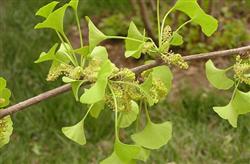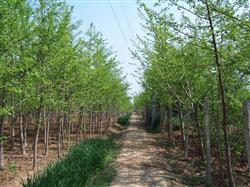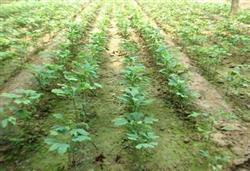How to make ginkgo early blossom and early fruit

First, drawing branches starts from the young tree stage of Ginkgo biloba, and the plants with small branching angles open through drawing branches to ease the growth of trees and branches and promote flower formation. The convenient bag containing soil can be tied to the tip of the upright branch at the beginning of May. the weight of the soil bag is determined according to the growth of the branch and the requirement of pulling the branch. the more upright the branch is, the thicker the branch is, the heavier the soil bag is, and so is the soil bag with large opening angle. In general, the main branch is drawn at an angle of 45 degrees and 50 degrees, and the lateral branches are drawn at an angle of 55 degrees and 60 degrees, and the non-backbone branches are flattened. Second, cut cross-cutting above or below the short branch with a knife, reaching to the xylem in order to promote the short branch to accumulate a large amount of nutrients and accelerate the formation of flowers. The upper part of the short branch should be cut in winter to prevent the lower part of the nutrient from being transported upward and accumulate in the short branch, while in summer, it should be scratched under the short branch to prevent the upper part of the branch from being transported downward, so that the nutrient accumulates in the short branch and promotes the formation of flower buds. Third, girdling and annular inverted skin peel off a circle of cortex at the smooth base of the main branch or side branch with a sharp blade to promote the accumulation of nutrients from the upper branches and leaves to the short branches, which can quickly form flower buds. The key of this technology: first, the girdling time should be carried out before the flower bud differentiation, that is, from late May to the first and middle of June; second, the girdling width should be the diameter of the branch ring peeling 10, even if the thick branch girdling width should not exceed 1.5cm; third, the cutting depth should reach the xylem, but can not hurt the xylem; fourth, the ring peeling mouth should be flat and straight, smooth, clean, avoid pollution. After girdling, it is tightly bandaged with plastic film to prevent diseases and insects from infecting the injured part and promote the rapid healing of the injured part. Girdling in the first year will be effective in the following year. It must be noted that if the use is improper or the operation is not strict, it will cause the ring to peel off branches and die. Therefore, the first adopter can reverse the stripped cortex (upper and lower ends upside down) and then paste it on it, which is called ring peeling and upside down, and the operation essentials are the same as the ring peeling method, and the same effect can also be achieved. Fourth, the ring is cut at the base of the trunk or main or lateral branches with a sharp blade to cut horizontally to the depth of the xylem, which can be cut 3 times or 4 times in the same place, and the distance between the circle and the circle is 0.5 cm. The disadvantage of ring cutting is that it needs to be carried out year after year (the part of ring cutting needs to be changed in the second year) until the effect is stable. The treatment of controlling growth and promoting flowers of Ginkgo biloba must be carried out after 4 years of planting of grafted seedlings or 3 years after grafting of seedlings, the long branches of the plants are stout and can form short branches, and the first-year growth of the main branch can be extended to more than 50 cm.
- Prev

Conservation measures of Ginkgo biloba trees in summer
1. The life of Ginkgo biloba is very long, but improper planting management, especially the loss of topsoil, will make a large number of roots exposed on the surface. Ginkgo biloba growing on the slope is particularly prominent, when serious, the depth of root exposure can reach more than 30 cm. Therefore, we should do a good job of soil cultivation, so that the root system is buried below the soil surface, in order to fully develop.
- Next

Breeding of Ginkgo biloba seedlings by smooth wood cutting in autumn
1. Sand culture treatment collect branches of the same year around August 20, take 20 cm long and 30 cm as cuttings, immediately remove leaves (leaving a little petiole), bundle 10 into bundles and put them into sand culture beds. The humidity of green sand in the sand culture bed is held by hand and dispersed as soon as it is loosened. After 10-15 days of sand culture, the basal tissue of the cuttings healed and produced.
Related
- Fuxing push coffee new agricultural production and marketing class: lack of small-scale processing plants
- Jujube rice field leisure farm deep ploughing Yilan for five years to create a space for organic food and play
- Nongyu Farm-A trial of organic papaya for brave women with advanced technology
- Four points for attention in the prevention and control of diseases and insect pests of edible fungi
- How to add nutrient solution to Edible Fungi
- Is there any good way to control edible fungus mites?
- Open Inoculation Technology of Edible Fungi
- Is there any clever way to use fertilizer for edible fungus in winter?
- What agents are used to kill the pathogens of edible fungi in the mushroom shed?
- Rapid drying of Edible Fungi

